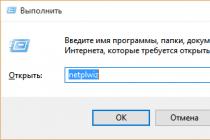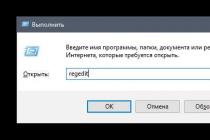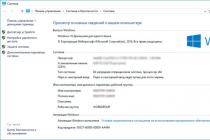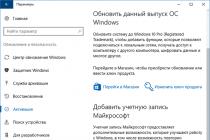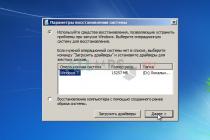", array (" (col_count) "=> $ this-> colCount," (row_count) "=> $ this-> rowCount)));)
But writing the rows is a more interesting process. The class should work quickly and process an unlimited amount of data, because records can be one hundred thousand or even a million! If you want speed, work with memory, if you want an unlimited amount of data, work with a disk. To reconcile the requirements, I implemented the resetRow and flushRow functions.
The first one clears the current row, after which it can be filled with data again, and the second one writes the current row to an open file to disk. Their use together allows you to strike a balance between speed and the amount of memory used.Public function resetRow () ($ this-> currentRow = array ();) public function flushRow () (fwrite ($ this-> file, implode ("", $ this-> currentRow)); unset ($ this-> currentRow);)
Each cell is written with a function corresponding to the data type, namely appendCellxxx, where xxx is the data type. Valid data types: Num, String, Real, DateTime, Date, Time, Link. An example of a function to write a numeric value:
Public function appendCellNum ($ value) ($ this-> currentRow = " | ". $ value." | ";
}
After writing all the data, it remains to close the worksheet and workbook.
Application
The use of the described class is based on exporting data using the CArrayDataProvider provider. However, assuming that the amount of exported data may be very large, a special CDataProviderIterator iterator was used, which iterates over the returned data by 100 records (you can specify a different number of records). Public function exportExcelXML ($ organization, $ user, & $ filename) ($ this -> _ provider = new CArrayDataProvider (/ * query * /); Yii :: import ("ext.AlxdExportExcelXML.AlxdExportExcelXML"); $ export = new AlxdExportExcelXML ($ filename, count ($ this -> _ attributes), $ this -> _ provider-> getTotalItemCount () + 1); $ export-> openWriter (); $ export-> openWorkbook (); $ export-> writeDocumentProperties ($ organization, $ user); $ export-> writeStyles (); $ export-> openWorksheet (); // title row $ export-> resetRow (); $ export-> openRow (true); foreach ($ this -> _ attributes as $ code => $ format) $ export-> appendCellString ($ this -> _ objectref-> getAttributeLabel ($ code)); $ export-> closeRow (); $ export-> flushRow (); // data rows $ rows = new CDataProviderIterator ($ this -> _ provider, 100); foreach ($ rows as $ row) ($ export-> resetRow (); $ export-> openRow (); foreach ($ this -> _ attributes as $ code => $ format) (switch ($ format-> type) (case "Num": $ export-> appendCellNum ($ row [$ code]); / * other types * / default: $ export-> append CellString (""); )) $ export-> closeRow (); $ export-> flushRow (); ) // close all $ export-> closeWorksheet (); $ export-> closeWorkbook (); $ export-> closeWriter (); // zip file $ export-> zip (); $ filename = $ export-> getZipFullFileName (); )
In my case, each row is written to disk, which, for now, is quite acceptable, but in the future, it may need to be changed. For example, it would be wise to save not every row, but every ten or even a hundred rows at a time. Then the export speed will increase.
Speed
By the way, on own experience saw how important it is to assume the possibility of large amounts of data in a batch operation such as export.
Initially, I tried to export data using CActiveDataProvider, which required about 240 seconds when exporting 1000 records! Changing the query to use CArrayDataProvider reduced the export time for 1000 records to 0.5 seconds!
Especially for this publication, I measured export indicators.
Exported 1626
records from 9
attributes that represent information about closed incidents (see TSM). The original view of the exported table
Result
(sorry, the picture disappears after posting) Export figures
Final file size: 1 312 269
Compressed file size: 141 762
Elapsed time: approximately 0.5
sec Anyone interested can get the source code of my class for free. Just remember to correct the function. writeDocumentProperties to decouple from the organization and user entities of the workflow system, or use their similar entities with the corresponding properties.
The question of how to save with 1C in XML file, worries people who work with company documentation and reports. These professionals include accountants. Today's standards imply the storage of most of the enterprise information in the 1C program. At the same time, the formation of documents in Excel remains in demand, because it is necessary for data processing, exchange of accounts with counterparties. The use of modern and progressive methods of transferring information between 1C and Excel greatly saves the time of the person who is doing this.
An unloading procedure is provided for the quick implementation of this operation. Going into 1C, the user selects the "File" section, then "Upload". On the hard disk of the computer or on a removable device, a specific location is selected where the file will be sent, and its format. If you need an Excel file, choose the XML format. It takes a long time to upload large documents. Before starting it, it is advisable to figure out what specific amount of information you are interested in and unload it. This is achieved by selecting the necessary blocks when working in 1C. If you need to add new positions to the existing data in XML, this is done by unloading into an existing document, during which the merge occurs. When you need to add multiple lines, it is easier to do this via the clipboard.
How to transfer data from XML file to 1C?
More often, during the work of an enterprise, you need to carry out the reverse procedure: get an Excel file in 1C. Let's see how to do this. Modern versions of 1C offer a similar procedure through the "Import" or "Download" tab. They are located in the same File category. The user selects the desired document on a computer or removable disk, after which it is loaded into the 1C database. 1C developers have provided for a "quarantine" zone, where files are first sent after downloading from other programs. Such a zone is needed to pre-check the validity of the data and especially the formatting. If the formatting is knocked down, you first need to restore it using special services or manually. Loading data with broken formatting in 1C leads to crashes and distortions in the database.
If there are difficulties in loading data or the format is constantly getting lost, then you need to check the relevance of the versions of the 1C and Excel programs. If you use modern versions, then the chance of problems is minimal.
Setting up serialization when porting to 1C
Serialization is the process of converting data from 1C to Excel and vice versa. The serialization procedure starts automatically when the user chooses to import or export data from 1C. It will not hurt to pre-configure the transfer and serialization of files. It is possible to select the file format, bit depth and other parameters that will help to avoid errors when exchanging data between different programs.
To upload a large number of files from Excel to 1C, you cannot do with standard copying. For such purposes, a special bootloader is being developed that connects to 1C and controls the boot procedure. Often a company has to order such a program for data transfer from developers, taking into account the specifics of a particular enterprise. It is costly, but pays off due to the fact that the download speed of salary files and other documents is noticeably increased, and errors during the transfer disappear.
Using web services to transfer data to 1C
To upload data to 1C, you can use specialized web services. They help to create an Excel file in 1C and do not require financial costs. You can upload information with their help once, or you can use such services all the time. It is advisable to choose services that are compatible with your versions of programs, then the likelihood of failures will become low.
The work of sending data with 1C 7.7 does not imply special education, but requires skills and experience. If an untrained employee gets down to business, it is advisable to control him so that the organization's database is not filled with inaccurate or damaged information.
In any data transfer procedure, great attention should be paid to the integrity of the data structure. As part of this, it is advisable to follow the recommendations below.
Before starting the download, make sure that the software versions are compatible.
Load data into the 1C "quarantine" zone so that unverified data does not immediately fall into a single database and do not distort it.
Check the format of the data that was received from Excel. If the format was knocked off during the transfer, it will take time to restore it. If this is not done, then individual cells can be summed up in an unpredictable way: quantity of goods with mass, price with total value. This will disrupt the statistics and data analysis system.
It is advisable that the downloaded data be checked by an experienced employee before being sent to the database: the owner of the enterprise, the chief accountant or another responsible person.
It is helpful for staff to develop and communicate file upload rules. Often errors and failures occur due to carelessness, absent-mindedness, negligence of individual employees. They enter data from two cells into one, use different abbreviations, different signs (period and comma) when writing fractional numbers, make other similar oversights that greatly confuse the format and lead to unwanted crashes and errors. For the management of the enterprise, it is worth developing a unified data recording format, then there will be fewer problems when transferring through a loader or manually. Automation of a company with the help of 1C developments assumes that employees of all levels will use a single program for data entry. Additional training can be useful if individual staff do not know how to use such a system or make mistakes when entering values.
Today, developers of programs like 1C offer constant updates that simplify work with data, so it doesn't hurt to check for updates and download them for the program. This will help you leverage the latest developments to simplify the loading and unloading of information.
I'll tell you quick way creating an xml file from the Excel table!
XML documents are very powerful and powerful. With the help of one XML file, you can fill your site with information in a matter of seconds! Indeed, in all modern engines (CMS) there is the ability to import from a hml file. So what am I doing.
As you know, * .xls formats (* .xlsx in 2007 office) are Microsoft formats Office Excel... 2003 office is a thing of the past, there is already 2010, but I work for 2007, and, therefore, I will tell based on it. Let's go!
1. Go to the Microsoft website, and download the add-on for working with XML. Download Excel 2003 Add-in: XML Tools Add-in. It doesn't weigh much, 397 KB.

2. Install it on your computer. There is nothing difficult to install. By default, the add-in is installed here: c: \ Office Samples \ OfficeExcel2003XMLToolsAddin
3. Now open Excel, go to the menu and select the "Excel Options" item.

4. In the window that appears, on the left, select the "Add-ons" item, and at the bottom of the window, click on the "Go ..."

5. A new window will open in front of you, in it you need to click the "Browse ..." button. How it looks is shown below.

6. Now you need to find the installed XmlTools add-on (watch). Select it and click OK!

7. If you did everything correctly, you will see the following window! Feel free to click OK, the installation is complete!

8. You have an add-in tab in the top menu, and XML Tools on the left.

We figured out the installation, and now we go directly to converting (exporting) xls to xml.
1. To do this, open the file with the data to be overtaken. Then we select the first item in the drop-down menu "Convert a Range to an XML List ..."

2. A small window will open in front of you, what do you need in it? There are radio buttons, No and Yes, what are they for? It's simple, if you have a header for the data (in my case, it is), select Yes, and if it does not exist, then accordingly No. Then click on the small rectangle on the top row.

3. Select the area of data that we are converting and click on the button on the right in the window that appears. The previous window is returned, in which we press OK.

4. Your plate should change, you can say transform, it looks like this to me:


6. In the drop-down list "File type" select XML data, click "Save".

I congratulate you, your file has been created!
I hope everything was presented in detail and understandable, but if you have any questions, please contact me!
2021
maccase.ru - Android. Brands. Iron. news

















